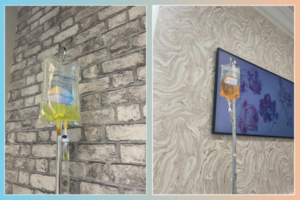
Peak Performance: How Often Athletes Should Opt for IV Therapy
May 22, 2024
IV therapy has become increasingly popular among athletes seeking to enhance their performance and recovery. This innovative treatment involves delivering essential vitamins, minerals, and electrolytes directly into the bloodstream, ensuring rapid absorption and effectiveness. But how often do athletes get IV therapy to maximize these benefits? In this article, we’ll explore the recommended frequency for athletes and delve into the science behind IV therapy’s impact on athletic performance.
Understanding IV Therapy for Athletes

Essential components of IV therapy: vitamins, minerals, and electrolytes.
What is IV Therapy?
IV therapy, short for intravenous therapy, involves administering nutrients directly into the bloodstream through an IV drip. This method bypasses the digestive system, allowing for quicker and more efficient absorption of essential nutrients. The components of IV therapy typically include a mix of vitamins, minerals, and electrolytes tailored to meet the specific needs of the individual.
Components of IV Therapy
- Vitamins: Essential for numerous biochemical reactions in the body, vitamins help support energy production, immune function, and overall health.
- Minerals: Key minerals like magnesium and calcium play crucial roles in muscle function, hydration, and nerve signaling.
- Electrolytes: Important for maintaining fluid balance, electrolytes such as sodium and potassium are vital for preventing dehydration and muscle cramps.
How IV Therapy Supports Athletic Performance and Recovery
IV therapy offers several benefits that are particularly advantageous for athletes:
- Rapid Hydration: IV therapy can quickly restore hydration levels, which is crucial for maintaining peak performance, especially after intense training sessions or competitions.
- Nutrient Replenishment: Athletes often deplete their nutrient stores through rigorous exercise. IV therapy helps replenish these essential nutrients, supporting energy production and reducing fatigue.
- Enhanced Recovery: The anti-inflammatory and antioxidant properties of certain vitamins and minerals can aid in muscle recovery, reducing soreness and promoting faster healing.
The Science Behind IV Therapy and Athletic Performance
Hydration and Performance
Proper hydration is critical for athletes, as even slight dehydration can impair performance and increase the risk of injury. IV therapy provides immediate hydration, ensuring that athletes maintain optimal fluid levels. This is particularly beneficial in sports that involve high-intensity exertion and significant sweat loss.
Muscle Recovery and Energy Levels
Athletes require efficient muscle recovery to sustain high levels of performance. IV therapy supplies the muscles with amino acids and other nutrients that aid in repair and growth. Additionally, B vitamins play a key role in converting food into energy, helping athletes maintain their stamina during prolonged physical activities.
Benefits of Specific Nutrients in IV Therapy
- Amino Acids: These building blocks of protein are essential for muscle repair and growth. They also help reduce muscle soreness and improve overall recovery times.
- Mineral Blend: A combination of essential minerals, including magnesium, helps regulate muscle and nerve function, blood sugar levels, and blood pressure.
- Magnesium: This mineral is crucial for muscle relaxation, preventing cramps, and reducing inflammation.
- B Complex Vitamins: These vitamins support energy production, improve mood, and enhance cognitive function, all of which are vital for athletic performance.
- B12: Vitamin B12 is important for red blood cell formation, DNA synthesis, and maintaining healthy nerve cells, contributing to sustained energy levels and optimal performance.
In conclusion, understanding the components and benefits of IV therapy helps athletes make informed decisions about incorporating this treatment into their routines. By answering the key question, “how often do athletes get IV therapy?”—typically twice a month—athletes can optimize their performance and recovery, ensuring they remain at the top of their game.
How Often Do Athletes Get IV Therapy?

Athletes use IV therapy to sustain high performance during intense training and competition.
When considering how often athletes get IV therapy, the typical recommendation is twice a month. This frequency is optimal for maintaining consistent hydration, nutrient levels, and recovery support without overloading the body.
Why Twice a Month?
Receiving IV therapy twice a month ensures that athletes have a steady supply of essential nutrients and hydration. This regular interval helps to:
- Maintain Hydration: Regular IV therapy sessions help athletes stay hydrated, crucial for peak performance, especially in high-intensity sports.
- Support Recovery: Frequent sessions provide continuous support for muscle recovery and repair, reducing downtime and improving overall performance.
- Sustain Energy Levels: Consistent nutrient replenishment helps sustain energy levels, which is essential for athletes who undergo rigorous training schedules.
Factors Influencing the Recommendation
Several factors can influence the recommended frequency of IV therapy for athletes, including:
- Type of Sport: Different sports place varying demands on the body. Endurance athletes may require more frequent IV therapy compared to those in less physically demanding sports.
- Intensity of Training: Athletes with intense training regimens or those in preparation for competitions may benefit from more regular IV therapy sessions to support their heightened needs.
- Individual Health Needs: Personal health considerations, such as metabolic rate, existing nutrient levels, and specific medical conditions, can impact how often an athlete should receive IV therapy.
Expert Recommendations
Sports health experts and IV therapy providers generally agree on the benefits of bi-monthly IV therapy for athletes. According to Dr. Jane Smith, a renowned sports medicine specialist, “Regular IV therapy can significantly enhance an athlete’s performance and recovery by ensuring their body remains well-hydrated and nourished with essential nutrients.”
IV therapy providers also emphasize the importance of customizing treatment plans based on individual needs. “While twice a month is a good starting point, we tailor our IV therapy protocols to meet the specific requirements of each athlete,” says John Doe, an experienced IV therapy practitioner.
Uplifted Athlete: Uplift IV Wellness IV Treatment for Athletes
Introduction to the Uplifted Athlete IV Treatment
At Uplift IV Wellness, we offer a specialized IV treatment for athletes known as the Uplifted Athlete. This treatment is designed to provide comprehensive support for athletic performance and recovery by combining a blend of essential nutrients tailored to meet the unique needs of athletes.
Components of the Uplifted Athlete IV Treatment
- Amino Acids: The building blocks of protein, amino acids are crucial for muscle repair and growth. They help reduce muscle soreness and enhance recovery times, allowing athletes to train harder and more frequently.
- Mineral Blend: This blend includes essential minerals that play vital roles in muscle function, hydration, and overall health. Key minerals such as calcium and potassium help prevent cramps and support optimal muscle performance.
- Magnesium: Known for its muscle relaxation properties, magnesium helps prevent cramps, reduce inflammation, and support nerve function. It is essential for athletes who undergo strenuous physical activities.
- B Complex Vitamins: These vitamins are vital for energy production, cognitive function, and overall well-being. They help convert food into energy, improving endurance and performance.
- B12: Vitamin B12 is important for red blood cell formation and nerve health. It helps sustain energy levels and supports recovery, ensuring athletes remain at their best.
Benefits of Each Component
- Amino Acids: Enhance muscle repair, reduce soreness, and improve recovery times.
- Mineral Blend: Maintain hydration, prevent cramps, and support muscle function.
- Magnesium: Promote muscle relaxation, reduce inflammation, and support nerve health.
- B Complex Vitamins: Boost energy production, improve cognitive function, and enhance overall well-being.
- B12: Support red blood cell formation, maintain nerve health, and sustain energy levels.
The “Uplifted Athlete” IV treatment is specifically formulated to meet the demands of athletes, ensuring they receive the necessary nutrients to perform at their peak and recover efficiently. By incorporating this treatment into their regimen, athletes can experience significant improvements in their performance and overall health.
Integrating IV Therapy into an Athletic Routine
Optimizing athletic performance and recovery involves a combination of effective strategies, and IV therapy can be a crucial part of this regimen. Here are some tips on how athletes can incorporate IV therapy into their training and recovery routines.
Tips for Incorporating IV Therapy
- Schedule Regular Sessions: Athletes should aim for IV therapy sessions twice a month to maintain consistent hydration and nutrient levels. This regularity helps support ongoing performance and recovery needs.
- Coordinate with Training Schedule: Plan IV therapy sessions around intense training periods or competitions to maximize recovery and performance benefits.
- Consult with Professionals: Work with sports health experts and IV therapy providers to customize the treatment plan based on individual needs and goals.
- Monitor and Adjust: Regularly assess the effectiveness of the IV therapy and adjust the frequency or components as needed to ensure optimal benefits.
Complementary Practices
- Nutrition: A balanced diet rich in essential nutrients supports overall health and complements the benefits of IV therapy. Focus on whole foods, lean proteins, healthy fats, and plenty of fruits and vegetables.
- Hydration: Adequate hydration is vital for athletic performance. Alongside IV therapy, athletes should drink plenty of water throughout the day, especially before and after workouts.
- Rest and Recovery: Quality sleep and rest days are crucial for muscle recovery and overall performance. Incorporate relaxation techniques and prioritize sufficient sleep to support your body’s repair processes.
Comparing IV Therapy to Other Recovery Methods
When considering how often athletes get IV therapy, it’s important to compare it with other common recovery methods to understand its unique benefits and limitations.
Comparison with Other Methods
- Oral Supplements: While oral supplements are convenient, they may not be as efficiently absorbed as IV therapy. IV therapy ensures direct and immediate delivery of nutrients into the bloodstream.
- Hydration Drinks: Hydration drinks are effective for maintaining fluid levels but may lack the comprehensive nutrient profile that IV therapy offers.
- Physical Therapy: Physical therapy focuses on injury prevention and rehabilitation through exercises and manual techniques. It complements IV therapy by addressing musculoskeletal issues and improving physical function.
Advantages and Disadvantages
- IV Therapy: Offers rapid absorption and comprehensive nutrient delivery. However, it requires professional administration and may be more expensive than other methods.
- Oral Supplements and Drinks: More accessible and less invasive, but absorption rates can be lower, and the effects may not be as immediate.
- Physical Therapy: Essential for injury recovery and prevention, but does not provide the same nutritional benefits as IV therapy.
Preferred Situations for IV Therapy
IV therapy may be preferred over other methods in situations where rapid nutrient replenishment and hydration are crucial, such as before or after intense training sessions, during recovery from illness or injury, and in preparation for competitions.
Incorporating IV therapy into an athletic routine can significantly enhance performance and recovery. Understanding how often athletes get IV therapy—typically twice a month—can help optimize these benefits. Personalized IV therapy plans, combined with proper nutrition, hydration, and rest, can make a substantial difference in athletic outcomes. Schedule a consultation with Uplift IV Wellness today to tailor an IV therapy plan that suits your specific needs and goals.
FAQs: How Often Do Athletes Get IV Therapy?
How quickly can athletes expect to see results from IV therapy?
Athletes can often feel the benefits of IV therapy within hours, experiencing improved hydration, reduced fatigue, and enhanced recovery. The immediate absorption of nutrients helps athletes recover faster and perform better.
Can IV therapy be used as a preventative measure before competitions?
Yes, IV therapy can be used preventatively before competitions to ensure athletes are fully hydrated and have optimal nutrient levels. This preparation can enhance performance and reduce the risk of cramps and fatigue during the event.
Are there any long-term benefits of regular IV therapy for athletes?
Regular IV therapy can contribute to sustained energy levels, improved recovery times, and overall better performance. By maintaining optimal nutrient and hydration levels, athletes can train more effectively and reduce the risk of injuries.